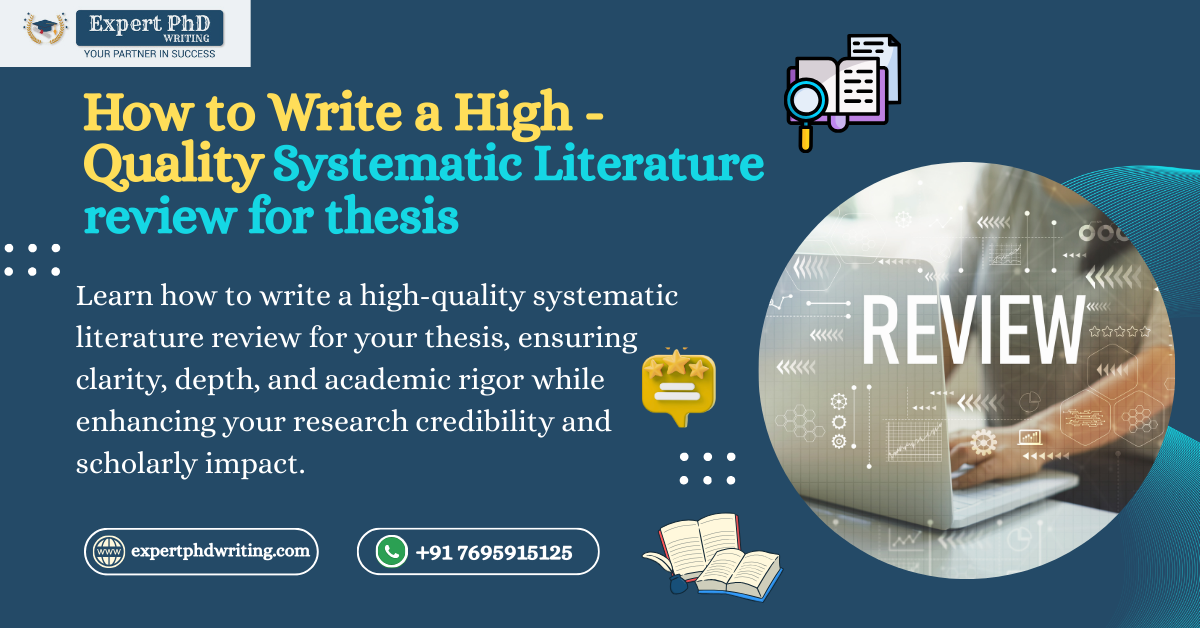

A Systematic Literature Review (SLR) is a structured, transparent, and reproducible method for identifying, evaluating, and synthesizing research relevant to a focused question. In thesis writing, an SLR is essential for establishing a strong research foundation, identifying gaps, and justifying your study. This PRISMA-aligned guide explains how to plan your review protocol, search academic databases, apply inclusion and exclusion criteria, and conduct a Systematic Literature Review effectively, ensuring you present results clearly and create a high-quality literature review that ranks well in academic and Google searches.
A precise question drives inclusion criteria, keywords, and synthesis. Use a framework that fits your field:
Weak: “What are the benefits of online learning?”
Stronger: “What effect do gamified online learning platforms have on first‑year STEM undergraduates’ motivation and academic performance?”
Write a protocol that covers objectives, inclusion/exclusion criteria, databases, date limits, keywords/synonyms/MeSH, quality appraisal tools, and your planned synthesis approach. If applicable, register it (e.g., PROSPERO) to enhance transparency.
Search multiple databases relevant to your domain: Scopus, Web of Science, PubMed, ERIC, and Google Scholar. Balance sensitivity (finding everything) with specificity (keeping it relevant). A well-structured search strategy is essential for effective Thesis Writing, ensuring that the literature you include is both comprehensive and highly relevant to your research objectives.
| Example Search String (edit to your topic) |
|---|
| ("online learning" OR "e-learning" OR "digital education") AND ("gamification" OR "game-based") AND ("undergraduate" OR "first-year") AND ("motivation" OR "academic performance") |
Document everything: databases, dates, filters, and exact strings. Save screenshots or export results for your appendix to maintain transparency and reproducibility.
Tools like Rayyan or Covidence enable faster, blinded screening ideal for team reviews.
Use a structured sheet (Excel/Sheets/NVivo) to capture: author, year, country, design, sample, measures/interventions, key findings, limitations, and quality rating. Keep variable names consistent to simplify synthesis.
Select tools aligned to designs: CASP (qualitative/observational), Cochrane RoB (trials), or JBI (various). Report how appraisal influenced inclusion and interpretation.
Qualitative synthesis: organize themes, patterns, and contradictions using thematic or framework synthesis.
Quantitative synthesis: where appropriate, conduct a meta‑analysis (pooled effect sizes, heterogeneity, sensitivity analyses).
Use visual summaries theme maps, forest plots, and comparative tables for examiner‑friendly readability.
Include a PRISMA flow diagram to document identification, screening, eligibility, and included studies. Presenting results effectively is an essential part of your Research Methodology, ensuring that your findings are clear, structured, and easy to interpret. Provide a characteristics table (year, region, design, sample, outcomes) and a findings table (key results, quality rating) to summarize the evidence in a concise yet comprehensive way.
Need help? Our team can design your protocol, run searches, screen studies, appraise quality, and write a PRISMA‑compliant synthesis aligned to your thesis guidelines.
Explore Publication & SLR Support • Related: PhD Thesis Help (USA) • Chat on WhatsApp
An SLR is a structured, transparent, and reproducible method to identify, screen, appraise, and synthesize research evidence on a focused question, often guided by PRISMA.
It grounds your thesis in credible evidence, reveals research gaps, and shows your ability to critically evaluate and synthesize studies.
A traditional review is narrative and selective; an SLR follows a predefined protocol, systematic database searches, explicit inclusion/exclusion criteria, and quality appraisal.
PRISMA isn’t always mandatory, but it’s widely recommended and often required to ensure transparent reporting via a flow diagram and checklist.
Common choices include Scopus, Web of Science, PubMed, ERIC, and Google Scholar. Select databases that fit your discipline and question.
Use Rayyan or Covidence for screening, Excel or NVivo for data extraction/coding, and RevMan or R for meta‑analysis where appropriate.
Timelines vary by scope and resources; expect several weeks to a few months, especially when multiple reviewers collaborate.
Vague research questions, undocumented search strategies, skipping quality appraisal, and over‑interpreting weak or heterogeneous results.
Yes theses, reports, and conference papers can reduce publication bias. Apply clear quality criteria before inclusion.
Include a PRISMA flow diagram, study characteristics and findings tables, and a clear synthesis highlighting patterns, gaps, and implications.